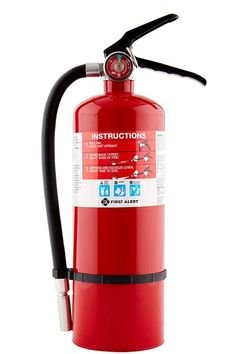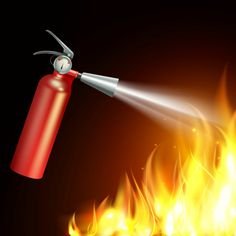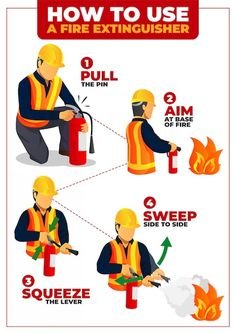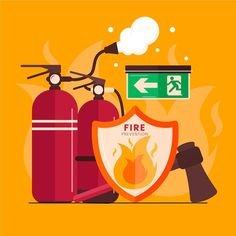Fire Extinguisher and Safety
Fire safety is a critical aspect of personal and workplace safety. Fires can occur unexpectedly and escalate rapidly, posing significant risks to life, property, and the environment. Understanding fire extinguishers, their types, proper usage, and general fire safety practices is essential for both preventing fires and effectively responding to them when they occur.

Understanding Fire:
Fire is a chemical reaction involving the rapid oxidation of a combustible material, typically with the release of heat and light. For a fire to ignite and sustain, three elements are necessary:
- Heat: Sufficient heat must be present to raise the temperature of the material to its ignition point.
- Fuel: Combustible materials such as wood, paper, fabric, flammable liquids, gases, and electrical equipment provide the fuel source.
- Oxygen: Air supplies the oxygen necessary to sustain combustion.
This trio of elements is often referred to as the “fire triangle.” Removing any one of these elements can extinguish a fire or prevent it from starting.
Classes of Fires:
Fires are categorized into different classes based on the type of fuel involved. The classification system helps determine the appropriate fire extinguisher and firefighting methods:

- Class A: Fires involving ordinary combustible materials such as wood, paper, cloth, and plastics.
- Class B: Fires fueled by flammable liquids and gases such as gasoline, oil, grease, and propane.
- Class C: Fires involving energized electrical equipment, where the primary hazard is the risk of electric shock.
- Class D: Fires involving combustible metals such as magnesium, titanium, sodium, and potassium.
- Class K: Fires involving cooking oils and fats, typically found in commercial kitchens.
Each class of fire requires a specific type of fire extinguisher designed to effectively suppress the fire without exacerbating the situation.
Types of Fire Extinguishers:
Fire extinguishers are portable devices used to extinguish or control small fires. They come in various types, each designed to tackle fires involving specific classes of materials:
- Water and Foam (Class A): Suitable for Class A fires involving ordinary combustibles. Water extinguishers are effective against materials like wood, paper, and textiles. Foam extinguishers create a barrier between the fuel and the oxygen in Class A fires, smothering the flames.
- Carbon Dioxide (CO2) (Class B and C): Effective for Class B (flammable liquids and gases) and Class C (electrical) fires. CO2 extinguishers work by displacing oxygen, effectively smothering the fire without leaving residue or causing damage to electrical equipment.
- Dry Chemical (Class A, B, and C): Multipurpose dry chemical extinguishers are suitable for Class A, B, and C fires. They contain a powder-based agent that interrupts the chemical reaction of the fire, extinguishing it rapidly.
- Halon (Class B and C): Halon extinguishers were once common for Class B and C fires but are now largely phased out due to their ozone-depleting properties. They worked by disrupting the chemical reaction of the fire.
- Wet Chemical (Class K): Specifically designed for Class K fires involving cooking oils and fats. Wet chemical extinguishers create a barrier between the oil and the oxygen, cooling the oil and preventing reignition.
- Clean Agent (Class B and C): Clean agent extinguishers use non-conductive, non-corrosive gases to suppress Class B and C fires, making them suitable for use in sensitive electronic and data equipment areas.
Choosing and Using Fire Extinguishers:

When selecting a fire extinguisher, consider the potential fire hazards present in your environment and ensure that the extinguisher is appropriate for the classes of fires likely to occur. Understanding the following key elements will help you effectively use a fire extinguisher:
- PASS Technique:
- Pull the pin: Pull the pin at the top of the extinguisher to break the seal.
- Aim low: Aim the nozzle or hose at the base of the fire, not at the flames themselves.
- Squeeze the handle: Squeeze the handle or lever to discharge the extinguishing agent.
- Sweep from side to side: Sweep the nozzle or hose from side to side until the fire is extinguished. Continue to watch for re-ignition.
- Safety Precautions:
- Ensure you have a clear escape route and never allow the fire to come between you and the exit.
- Always approach a fire with caution and be prepared to evacuate if the fire becomes uncontrollable.
- Use the appropriate type and size of extinguisher for the fire. Using the wrong type can be ineffective or dangerous.
- Never turn your back on a fire until you are certain it is fully extinguished.
- Maintenance:
- Regularly inspect fire extinguishers to ensure they are in good working condition.
- Check the pressure gauge monthly to ensure the extinguisher is charged and ready for use.
- Schedule professional maintenance and servicing according to manufacturer guidelines.
Fire Safety Practices:
Beyond fire extinguishers, implementing comprehensive fire safety practices is essential to minimize fire risks and ensure a safe environment:

- Fire Prevention:
- Keep flammable materials and sources of ignition away from each other.
- Store flammable liquids and gases in approved containers and away from heat sources.
- Maintain electrical equipment and wiring to prevent overheating and electrical fires.
- Smoke Alarms and Detection:
- Install smoke alarms in key areas of your home or workplace and test them regularly.
- Ensure smoke alarms are interconnected so that if one sounds, they all sound.
- Replace smoke alarm batteries annually or as needed.
- Emergency Evacuation Plan:
- Develop and practice an emergency evacuation plan with all occupants or employees.
- Designate primary and secondary evacuation routes and assembly points.
- Ensure everyone knows how to respond to fire alarms and emergency notifications.
- Training and Education:
- Provide fire safety training to employees, tenants, or household members.
- Train individuals on the proper use of fire extinguishers and evacuation procedures.
- Conduct fire drills regularly to practice response and evacuation.
- Fire Safety Equipment:
- Ensure adequate fire safety equipment is available, including fire extinguishers, fire blankets, and emergency exit signs.
- Maintain clear access to fire exits and keep them free from obstruction.
Conclusion:
Fire extinguishers are vital tools in fire safety, allowing individuals to intervene quickly and effectively in containing small fires before they escalate. Understanding the types of fire extinguishers, their appropriate uses, and practicing safe handling techniques can make a significant difference in protecting lives and property. Coupled with comprehensive fire safety practices and education, including prevention, detection, and evacuation planning, fire extinguishers contribute to a proactive approach to fire safety that enhances overall preparedness and minimizes risk in residential, commercial, and industrial settings.
